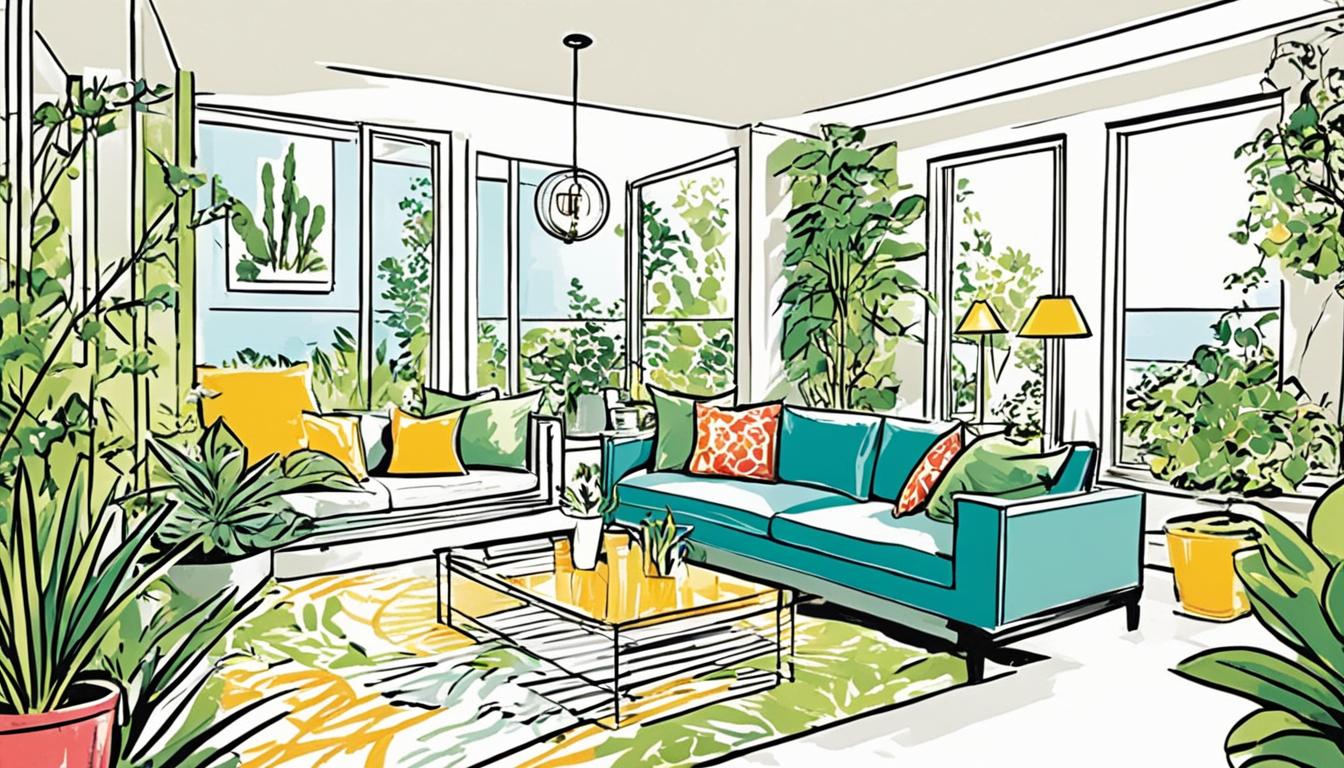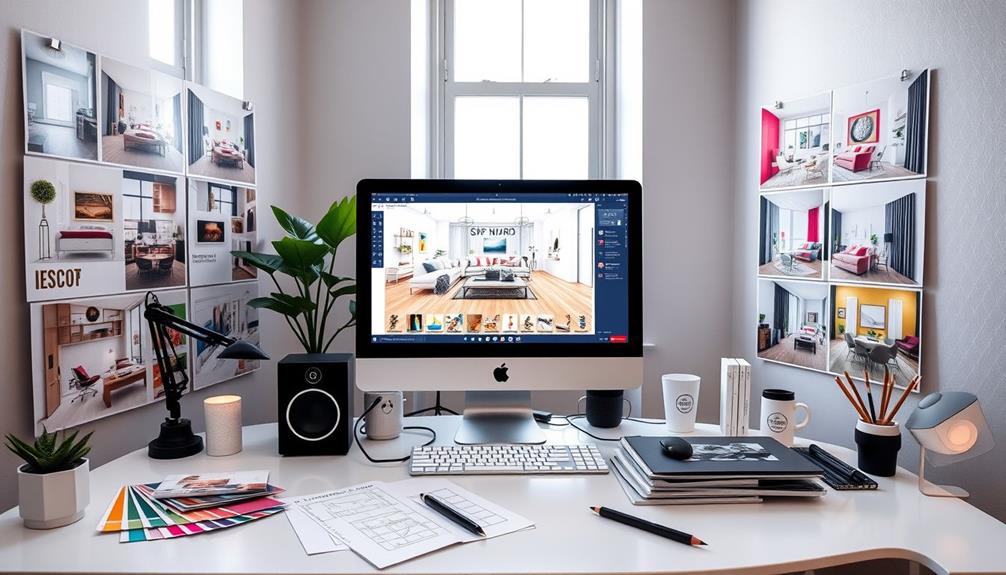Embarking on a journey in the interior design industry blends creativity with business acumen. To truly understand how to succeed in interior design, it’s essential to grasp the landscape of the industry, including market trends, competition, and consumer needs. Achieving interior design career success requires a strategic approach that goes beyond mere passion for aesthetics. It encompasses effective planning, strong business skills, and adaptability to the ever-evolving demands of the market.
A staggering 20% of small businesses fail within their first year, with nearly 50% folding by the end of their fifth year, according to the U.S. Small Business Administration. Furthermore, about 70% of small businesses struggle with cash flow issues. Therefore, developing robust strategies for success in interior design is paramount for ensuring longevity in your career. This article serves as a comprehensive guide, unveiling key strategies that can pave your path to triumph in the dynamic world of interior design.
Key Takeaways
- Understanding market trends is essential for staying competitive.
- A strong portfolio showcasing unique styles can attract potential clients.
- Effective financial management is key to business sustainability.
- Building strong client relationships leads to referrals and repeat business.
- Continuous learning ensures you remain adaptable in the industry.
- Establishing an online presence is crucial for visibility.
- Strategic marketing initiatives can enhance brand awareness.
Understanding the Interior Design Industry
A comprehensive understanding of the interior design industry is essential for anyone looking to thrive in this competitive field. The industry encompasses a range of services, from residential and commercial design to public spaces. Staying current with market dynamics helps you anticipate shifts and align your strategies effectively.
Current Market Trends
Today’s interior design landscape showcases several key trends. Increasingly, clients seek sustainable and luxurious designs, driven by urbanization and evolving lifestyles. By 2018, revenues from interior design services in the United States reached approximately 12 billion U.S. dollars. Usage of computer-based design programs has surged, allowing designers to create detailed 2D and 3D visuals, vital for meeting client expectations influenced by popular home design TV shows.
Identifying Your Target Market
Identifying your target market is a crucial step for effective service delivery. Whether you focus on residential or commercial projects impacts your approach significantly. In regions like California, clients often request eco-friendly features, so knowledge of sustainable practices will give you an advantage. Understanding what drives particular demographics helps in tailoring services to their specific needs and preferences.
Analyzing the Competition
Analyzing competition in the interior design sector reveals valuable insights. Understanding what other designers offer can shape your business strategies and differentiate your services. A strong reputation and excellent job placement can also be crucial factors when building your brand. As approximately 90% of clients choose to proceed with further work after initial consultations, optimizing your initial interactions can significantly enhance your success.

Creating a Compelling Portfolio
Your portfolio serves as the visual representation of your skills and creativity as an interior designer. Creating a compelling portfolio is essential for attracting potential clients and employers. Start by focusing on projects that showcase your unique design approach and versatility. Including around 5 to 7 carefully selected projects can provide a balanced view of your capabilities.
Showcasing Your Unique Style
When showcasing your unique style, it is vital to include various types of projects. For beginners, a mix of commercial, hospitality, and residential designs can demonstrate your breadth. Aim for your portfolio to contain about 80% residential work, as it resonates more with potential clients. Utilize high-resolution images and detailed descriptions to highlight your specific style and the skills involved in each project.
Including Before-and-After Projects
Before-and-after images can significantly enhance your portfolio. These images visually communicate your problem-solving abilities and effective design transformations. Portfolios that feature such comparisons are 70% more likely to attract interest. This strategy not only showcases your skills but also builds trust, as potential clients can easily see the impact of your work.
Importance of an Online Portfolio
In today’s digital age, the online portfolio importance cannot be overstated. Maintaining an updated web portfolio allows wider access for potential clients. It’s recommended to ensure your online presence is engaging through elements like visuals, client testimonials, and blogs. Portfolios that use website builders like Squarespace or WordPress often see a 20% increase in user engagement. Including a Services page can further boost client inquiries by 15%, making your portfolio an essential tool for growing your business.

| Portfolio Element | Impact |
|---|---|
| High-resolution Images | 75% more engaging for viewers |
| Before-and-After Examples | 70% more likely to attract clients |
| Diverse Project Types | 80% residential focus recommended |
| Client Testimonials | 25% increase in credibility |
| Contact and Social Media | 30% increase in inquiries |
Crafting an Effective Business Plan for Your Interior Design Firm
Creating a well-structured business plan is fundamental for the success of your interior design firm. This document acts as a roadmap, guiding you through the various phases of your business journey. Start by defining your business model, outlining how you will charge clients—whether through hourly rates, flat fees, or project percentages. Such clarity will help in crafting an effective business plan tailored to your unique firm.
Defining Your Business Model
Defining your business model is paramount. Tailor your offerings based on detailed market analysis, ensuring alignment with your potential clients’ preferences. Assess your capabilities and set pricing strategies reflecting your market’s demand alongside the value you provide. This step will enhance your ability to attract clients and secure a solid position in the competitive landscape.
Financial Projections and Funding
Financial projections are essential. Develop a comprehensive financial plan that details revenue projections, expenses, and profit targets. Address startup costs and identify multiple revenue streams to sustain your firm in the long run. Understanding your financial status is crucial when seeking funding, as potential investors will look for well-articulated and realistic financial projections. Regular monitoring of your business’s performance will allow you to tweak your financial strategies as needed.
Marketing and Sales Strategies
Crafting potent marketing strategies is vital to attract new clients. Integrate both online and offline methods to establish your brand presence. Utilize social media, networking events, and collaborations to increase visibility. Establishing a clear marketing framework enhances client acquisition efforts and reinforces your brand identity. Regularly assess and adapt these marketing strategies to optimize your outreach and engagement.
By focusing on these core areas—defining your business model, establishing sound financial projections, and implementing effective marketing strategies—you will create a robust foundation for your interior design firm. Monitoring progress, seeking feedback, and continuously refining your approach will position your business for growth and success.
| Key Element | Description |
|---|---|
| Business Model | Outline how services are charged and tailor offerings to market demand. |
| Financial Projections | Detail revenue sources, expenses, and profit targets, including risks. |
| Marketing Strategies | Employ various channels to enhance brand awareness and client acquisition. |
| Operational Processes | Define workflows for client communication, project management, and quality assurance. |

Essential Marketing Strategies for Your Interior Design Business
In the competitive landscape of interior design, implementing essential marketing strategies is crucial for your business success. A strong approach to brand identity building helps distinguish your services from others in the market. By developing a unique voice and visual style, you can foster recognition among potential clients. Engaging in effective online marketing techniques allows you to reach a wider audience than traditional methods alone.
Building Your Brand Identity
Your brand identity forms the foundation of how clients perceive your interior design business. Focus on crafting a cohesive message across your marketing materials, including your website, social media, and printed materials. Highlight your unique style through engaging visuals and consistent storytelling. The use of platforms like Instagram and Pinterest offers excellent opportunities for showcasing your work, enabling clients to envision their dream spaces through your designs.
Online Marketing Techniques
Online marketing is pivotal in establishing your presence in the interior design industry. Utilize Google My Business to enhance visibility; about 50% of businesses attract more than 1,000 views per month, potentially translating into significant leads. Social media platforms like Instagram, which boasts over 1 billion monthly active users, are essential for targeting a vast audience. Engaging content not only increases interaction but can lead to clients spending 30% more with businesses that actively connect with them. Consider integrating Google Ads to place your services at the forefront of search results for selected keywords, maximizing your visibility further.
Utilizing Offline Marketing Strategies
While online marketing plays a vital role, do not overlook the impact of offline marketing strategies. Attending trade shows and community events allows you to build personal connections with potential clients. Direct interaction offers a memorable experience that can set your business apart. Engaging local businesses and forming partnerships can further enhance your credibility and lead sources. Focus on building relationships within your community to foster loyalty and generate referrals.

Building a Strong Client Base
Creating a strong client base serves as the backbone of any successful interior design business. You can achieve this through exceptional customer service, effective networking, and actively seeking client feedback. Understanding how each of these elements relates to your business will pave the way for growth and sustainability.
Delivering Exceptional Customer Service
Exceptional customer service must be a priority. When you focus on understanding your clients’ needs, you foster loyalty and satisfaction. Open communication about project timelines, budgets, and expectations builds trust. Your clients will appreciate your efforts, and happy clients often become advocates for your brand, leading to referrals.
The Importance of Networking
Networking plays a significant role in expanding your reach. Building relationships with contractors, suppliers, and even referring businesses can open new doors for collaboration. Attending industry events helps you stay informed about market trends while connecting with potential clients. Engage with local community groups and online forums to establish your presence.
Leveraging Client Feedback for Growth
Regularly soliciting feedback from clients can lead to continuous improvement. Understanding their experiences gives you insights into what works and what needs adjustment. Accepting constructive criticism shows that you are committed to refining your services. Utilizing testimonials can serve as powerful social proof, reinforcing trust with prospective clients.

Legal Considerations for Your Interior Design Business
Navigating the legal landscape is a crucial part of establishing your interior design firm. Understanding legal considerations can help you avoid pitfalls and ensure your business operates smoothly.
Getting Your Business Registered
When launching your interior design business, proper business registration is essential. This includes applying for a business license, which builds credibility with your clients. Many interior designers choose to form a private limited company, a structure that conveys trust and professionalism. Understanding different legal entities such as sole proprietorships and LLCs will help you decide what suits your needs best.
Insurance Requirements
Securing the right insurance for your interior design firm protects your investment and mitigates risks. Professional liability insurance is vital as it safeguards against claims related to your services. Additionally, commercial property insurance protects your physical assets, ensuring you are covered in case of unforeseen incidents. Having comprehensive insurance demonstrates professionalism to clients and can help build long-term relationships.

| Legal Structure | Advantages | Disadvantages |
|---|---|---|
| Sole Proprietorship | Complete control; simple setup; direct tax benefits | Personal liability; harder to raise funds |
| Partnership | Shared responsibility; combined resources | Joint liability; conflicts between partners |
| Limited Liability Company (LLC) | Liability protection; flexible tax options | More regulatory requirements; potential fees |
| Corporation | Separate legal entity; better funding opportunities | Complex regulations; potential for double taxation |
How to Succeed in Interior Design
To thrive in the interior design field, you must embrace a culture of continuous learning and adaptability. Staying updated with the latest trends and techniques through workshops or online courses is fundamental. This ongoing education allows you to remain competitive in a dynamic market. Many successful designers have honed their craft through experience, demonstrating that personal taste often holds more weight than formal credentials.
Continuous Learning and Adaptability
Engaging in continuous learning fosters professional growth and keeps your design skills sharp. Interior design is an ever-evolving field. Engaging with new techniques, materials, and technologies not only enhances your expertise but also increases your market value. Flexibility is vital. Be responsive to client feedback and willing to incorporate changes into your designs. This ability ensures that you can meet and exceed client expectations, creating lasting impressions.
Exploring Specializations
As you consider ways to succeed in interior design, exploring specializations can significantly boost your appeal to potential clients. Fields such as sustainable design or commercial spaces offer unique opportunities to showcase your talents. Narrowing your focus enables you to develop expertise that sets you apart in a crowded market. Finding a niche helps in attracting clients who resonate with your vision and preferences. This strategic approach allows you to deliver tailored solutions while enhancing your credibility and marketability.

Conclusion
Achieving success in interior design is a multifaceted endeavor that combines creativity with business acumen. As discussed throughout this article, understanding the current market trends, maintaining a strong brand identity, and delivering exceptional customer service play vital roles in your journey. By implementing proven interior design success tips, you can effectively navigate the industry’s challenges and seize opportunities for growth. In addition, networking within the industry and building strong relationships with suppliers, contractors, and other professionals can also help propel your success in the field. By staying informed about the latest interior design technologies and techniques, and continuously honing your skills, you can position yourself as a leader in the industry. Keeping these interior design career tips in mind and consistently striving for excellence will allow you to achieve your professional goals and stand out in the competitive market.
The demand for interior design services continues to rise, revealing an expanse of possibilities for those ready to invest the necessary effort and time. While breaking into the interior design field may seem daunting, establishing an impressive portfolio and nurturing a solid reputation can significantly enhance your prospects. Remember, continuous education and adaptation to new trends are crucial elements in maintaining your competitive edge and ensuring you remain relevant in this dynamic industry.
Ultimately, successful interior designers thrive by mastering essential skills, managing client expectations, and showcasing a diverse range of design styles. By staying focused on your professional development and embracing every opportunity for learning, you can unlock your potential and create transformative spaces that resonate with your clients, paving your way toward interior design success.








